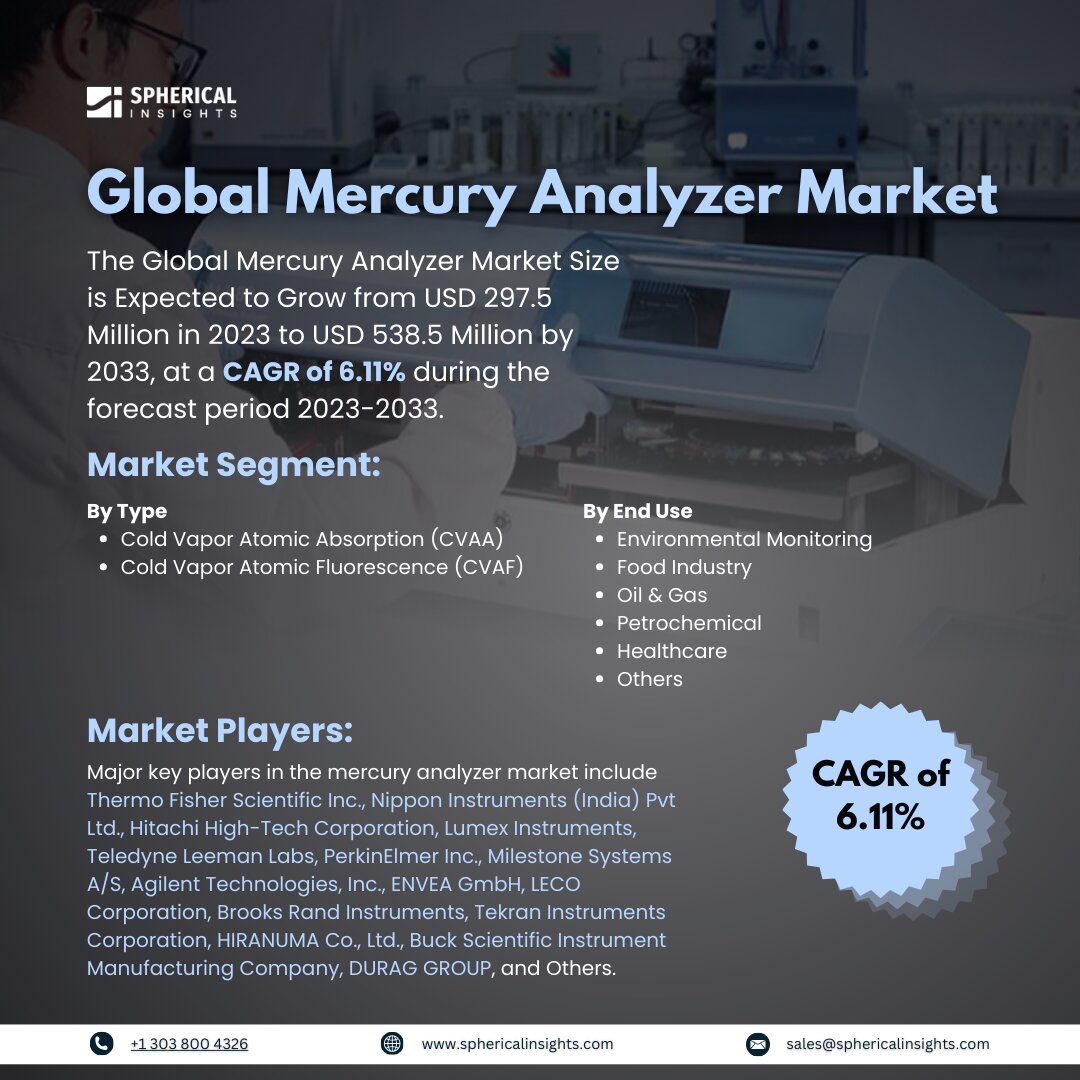Global Mercury Analyzer Market Size to worth USD 538.5 Million by 2033
According to a research report published by Spherical Insights & Consulting, the Global Mercury Analyzer Market Size is Expected to Grow from USD 297.5 Million in 2023 to USD 538.5 Million by 2033, at a CAGR of 6.11% during the forecast period 2023-2033.
Browse key industry insights spread across 210 pages with 110 Market data tables and figures & charts from the report on the Global Mercury Analyzer Market Size, Share, and COVID-19 Impact Analysis, By Type (Cold Vapor Atomic Absorption (CVAA) and Cold Vapor Atomic Fluorescence (CVAF)), By End Use (Environmental Monitoring, Food Industry, Oil & Gas, Petrochemical, Healthcare, and Others), and By Region (North America, Europe, Asia-Pacific, Latin America, Middle East, and Africa), Analysis and Forecast 2023 – 2033.
Mercury analyzer refers to the device that measures the amount of mercury in liquid, solid, and gas samples. It utilizes techniques including cold vapor atomic absorption and cold vapor atomic fluorescence spectrometry to separate atomic mercury from the sample’s matrix. The regulations for environmental protection, active government engagement, and regulatory entities for monitoring environmental conditions along with growing industrialization and urbanization in emerging economies are creating lucrative market growth opportunities. The technological advancements in mercury analyzers that improve the performance and accuracy of the devices are driving the market. Further, an increasing need for accurate and dependable mercury analyzers owing to the stringent government policies for minimizing mercury discharges is fueling the mercury analyzer market. On the contrary, the increased initial investments associated with manufacturing and procurement of mercury analyzers are challenging the market.
The cold vapor atomic absorption (CVAA) segment dominated the market with the largest revenue share in 2023.
Based on the type, the global mercury analyzer market is divided into cold vapor atomic absorption (CVAA) and cold vapor atomic fluorescence (CVAF). Among these, the cold vapor atomic absorption (CVAA) segment dominated the market with the largest revenue share in 2023. The operation of a mercury analyzer is based on the absorption of light by mercury vapor at a specific wavelength. The increased adoption due to its cost-effectiveness and high accuracy of higher mercury concentrations is responsible for driving the market.
The environmental monitoring segment accounted for the largest share of the mercury analyzer market in 2023.
Based on the end use, the global mercury analyzer market is divided into environmental monitoring, the food industry, oil & gas, petrochemicals, healthcare, and others. Among these, the environmental monitoring segment accounted for the largest share of the mercury analyzer market in 2023. The use of mercury analyzer devices for testing the quality of water, soil, and air for detecting mercury pollution is driving the market in the environmental monitoring segment.
Asia Pacific is projected to hold the largest share of the global mercury analyzer market over the forecast period.
Asia Pacific is projected to hold the largest share of the global mercury analyzer market over the forecast period. The increasing need from the manufacturing industries, mining activities, petrochemicals, and food processing activities are driving the market. The surging focus on environmental conservation, regulatory developments, and the significance of public health & awareness are propelling the market growth.
North America is predicted to grow at the fastest CAGR in the mercury analyzer market over the forecast period. The increased focus on environmental conservation, parallel regulatory developments, and the significance of public health & awareness is propelling the market. The stringent government regulations for chemical disposable in the air along with the rapid industrialization in emerging countries like China and India are propelling the market.
Competitive Analysis
Major key players in the mercury analyzer market include Thermo Fisher Scientific Inc., Nippon Instruments (India) Pvt Ltd., Hitachi High-Tech Corporation, Lumex Instruments, Teledyne Leeman Labs, PerkinElmer Inc., Milestone Systems A/S, Agilent Technologies, Inc., ENVEA GmbH, LECO Corporation, Brooks Rand Instruments, Tekran Instruments Corporation, HIRANUMA Co., Ltd., Buck Scientific Instrument Manufacturing Company, DURAG GROUP, and Others.
Key Target Audience
- Market Players
- Investors
- End-users
- Government Authorities
- Consulting And Research Firm
- Venture capitalists
- Value-Added Resellers (VARs)
Recent Developments
- In February 2024, Lumex Instruments is launching the successor to its highly popular Light-915 mercury analyzer. The new model would operate using Lumex’s proprietary Zeeman atomic absorption spectrometry (AAS) technology, which has served the industry so well for over 30 years, but the new version has seen significant improvements and developments added to further enhance industrial mercury monitoring.
- In January 2023, AIT strengthened its partnership with IDEA and NIC, Japan, with the launch of the new Mercury Lab. A Mercury Lab was launched at the IDEA EEM Laboratory/IDEA R&D Center of the Asian Institute of Technology supported by IDEA Consultants, Inc. and Nippon Instruments Corporation (NIC), Japan, and is one of a kind in South East Asia.
Market Segment
This study forecasts revenue at global, regional, and country levels from 2023 to 2033. Spherical Insights has segmented the global mercury analyzer market based on the below-mentioned segments:
Global Mercury Analyzer Market, By Type
- Cold Vapor Atomic Absorption (CVAA)
- Cold Vapor Atomic Fluorescence (CVAF)
Global Mercury Analyzer Market, By End Use
- Environmental Monitoring
- Food Industry
- Oil & Gas
- Petrochemical
- Healthcare
- Others
Global Mercury Analyzer Market, Regional Analysis
- North America
- Europe
- Germany
- Uk
- France
- Italy
- Spain
- Russia
- Rest of Europe
- Asia Pacific
- China
- Japan
- India
- South Korea
- Australia
- Rest of Asia Pacific
- South America
- Brazil
- Argentina
- Rest of South America
- Middle East & Africa
- UAE
- Saudi Arabia
- Qatar
- South Africa
- Rest of the Middle East & Africa



